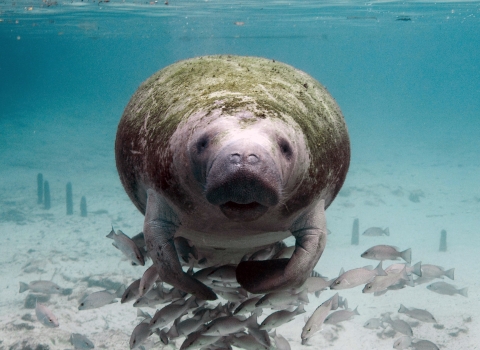Based on a review of the best available scientific and commercial information, the U.S. Fish and Wildlife Service has determined that three southeastern species – the pristine crayfish, Tennessee heelsplitter, and Georgia blind salamander - are not at risk of extinction and do not warrant listing under the Endangered Species Act (ESA).
For each species, the Service brought together a team of biologists that compiled and examined all known data and research. The peer-reviewed findings for each are outlined in the species status assessments (SSA). SSAs use the conservation biology principles of resiliency, redundancy, and representation. The SSA reports for each of these species and detailed descriptions of the basis for each of these findings will be published in the Federal Register on August 23, 2023 and are available online today at: https://federalregister.gov/public-inspection.
A small freshwater crustacean found in Tennessee, the pristine crayfish was first described as a species in 1965. At the time, the species was only known to occur in the Caney Fork River headwaters in the Cumberland Plateau. Since then, the known range of the species has expanded, and the crustacean can be found in 27 streams of the Caney Fork and Sequatchie River systems, all within the Cumberland Plateau. There are two recognized forms of the species: the Caney Fork form and the Sequatchie form. The Caney Fork form is restricted to the Caney Fork River system, while the Sequatchie form is found in the Sequatchie River system and streams within the Fall Creek Falls State Park in the Caney Fork River system. Although sedimentation and other water quality concerns influence both forms of the pristine crayfish, healthy populations in good habitat remain across the species’ small range.
The Tennessee heelsplitter is a small freshwater mussel less than two inches long. It occurs along river margins and in small headwater streams in Virginia, Tennessee, Georgia, Alabama, and historically in North Carolina. Although the heelsplitter faces threats from sedimentation and other water quality concerns as well as competition from nuisance species, these threats are not likely to impact the species to the point it will become endangered in the foreseeable future.
The Georgia blind salamander is a relatively small, pinkish white, blind salamander with only eyespots, and no eyes. It lives primarily in the caves of the Upper Floridan Aquifer system. Historical records of the Georgia blind salamander principally occurred in northwest Florida. Currently, locations where Georgia blind salamanders have been found include Calhoun, Jackson, and Washington Counties, Florida, as well as Decatur and Dougherty Counties, Georgia. Existing threats related to water quality and water quantity are present but water quantity in the Upper Floridian Aquifer is not currently an issue. After assessing the best available information, the Service has determined that the Georgia blind salamander does not meet the definition of an endangered species or threatened species and is therefore not warranted for listing under the ESA.
The Service will continue to support partners in their conservation and research efforts on behalf of these animals. We also ask the public to submit to us, at any time, new information that may be relevant to the status of any of these species or their habitats, as it becomes available.
Detailed descriptions and contact information for these findings will be available online at the Federal eRulemaking Portal on August 23, 2023: http://www.regulations.gov/ under the following docket numbers:
Species | Docket Number |
Pristine crayfish | FWS-R4-ES-2023-0115 |
| Tennessee heelsplitter | FWS-R4-ES-2023-0116 |
Georgia blind salamander | FWS-R4-ES-2023-0117 |
The mission of the U.S. Fish and Wildlife Service is working with others to conserve, protect, and enhance fish, wildlife, plants, and their habitats for the continuing benefit of the American people. For more information on our work and the people who make it happen, visit www.fws.gov. Connect with our Facebook page at www.facebook.com/usfwssoutheast, follow our tweets at www.twitter.com/usfwssoutheast, watch our YouTube channel at http://www.youtube.com/usfws and download photos from our Flickr page at http://www.flickr.com/photos/usfwssoutheast.


